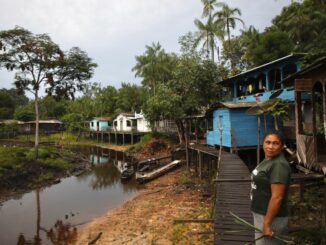
Essay by Eric Worrall
Last Year Amazon was forced to take all their solar panels offline, after the panels caused six separate fire and explosion incidents. Amazon blames third party installers for the problems.
Amazon took all U.S. solar rooftops offline last year after flurry of fires, electrical explosions
PUBLISHED THU, SEP 1 202212:10 PM EDTUPDATED 60 MIN AGOAnnie Palmer@ANNIERPALMERLora Kolodny@LORAKOLODNY
Between April 2020 and June 2021, solar panels atop Amazon fulfillment centers caught fire or experienced electrical explosions at least six different times.
“The rate of dangerous incidents is unacceptable, and above industry averages,” an Amazon employee wrote in an internal report viewed by CNBC.
Rooftop solar is part of Amazon’s broad plan to zero out emissions by 2040.
On the afternoon of April 14, 2020, dozens of firefighters arrived at an Amazon warehouse in Fresno, California, as thick plumes of smoke poured from the roof of the 880,000-square-foot warehouse.
Some 220 solar panels and other equipment at the facility, known as FAT1, were damaged by the three-alarm fire, which was caused by “an undetermined electrical event within the solar system mounted on top of the roof,” Leland Wilding, Fresno’s fire investigator, wrote in an incident report.
A little over a year later, about 60 firefighters were called to an even larger Amazon facility in Perryville, Maryland, to put out a two-alarm blaze, local news outlets reported.
In the intervening months, at least four other Amazon fulfillment centers caught fire or experienced electrical explosions due to failures with their solar energy-generating systems, according to internal company documents viewed by CNBC.
…
Amazon blamed third-party partners and vendors for the most significant problems uncovered by CEA and other teams working on facilities and sustainability initiatives.
…
Rooftop solar may be inherently unsafe.
Solar panels are low voltage high amperage devices, similar to the low voltage component of an electric welding machine arc. Any installation mistake or structural failure can cause 10s, even hundreds of amps to go where it is not intended.
Solar Panels are also usually mounted on Aluminium frames.
Aluminium has some attractive characteristics, it is cheap, easy to drill and cut, lightweight, which reduces or eliminates the need to reinforce existing roof supports, and is corrosion resistant.
But Aluminium also has some significant downsides. Aluminium has a very low melting point, it melts at around 1200F, far below the melting point of other common structural metals like Steel. Aluminium is a good electrical conductor, so it can carry and potentially be weakened or completely melted by stray currents from high amperage solar panels, though Aluminium is also an excellent heat conductor, which might mitigate the risk of melting. Aluminium is also vulnerable to salt or electrical corrosion, as any boat owner would know. Salt, electricity and aluminium is a bad mix, even small stray electrical currents can cause rapid oxidation and structural failure. Desert dust and sea breezes frequently contain a lot of salt.
Worst of all, hot Aluminium can form dangerous, difficult to extinguish flammable thermite mixtures which burn at many thousands of degrees with a wide variety of structural oxides, like titanium oxide, which is the magic pigment in heat reflecting paint, rusty steel, some roof tile materials, and glass.
I don’t know whether the chemical ability of electrically heated aluminium to form high temperature combustible mixtures with a wide variety of normally non-flammable structural materials is a factor in solar rooftop fires, but this seems a real possibility.
My question – if a large company like Amazon can’t get installers to do their job right, what hope to ordinary people have? Time will tell if insurers start adding a “rooftop solar” premium to household policies. At the very least, everyone who wants to install solar panels should review whether their rooftop material can form a dangerous thermite mix with the solar panel frame.
Update (EW): The following video is Aluminium mixed with internal wall plaster creating a white hot flame.



